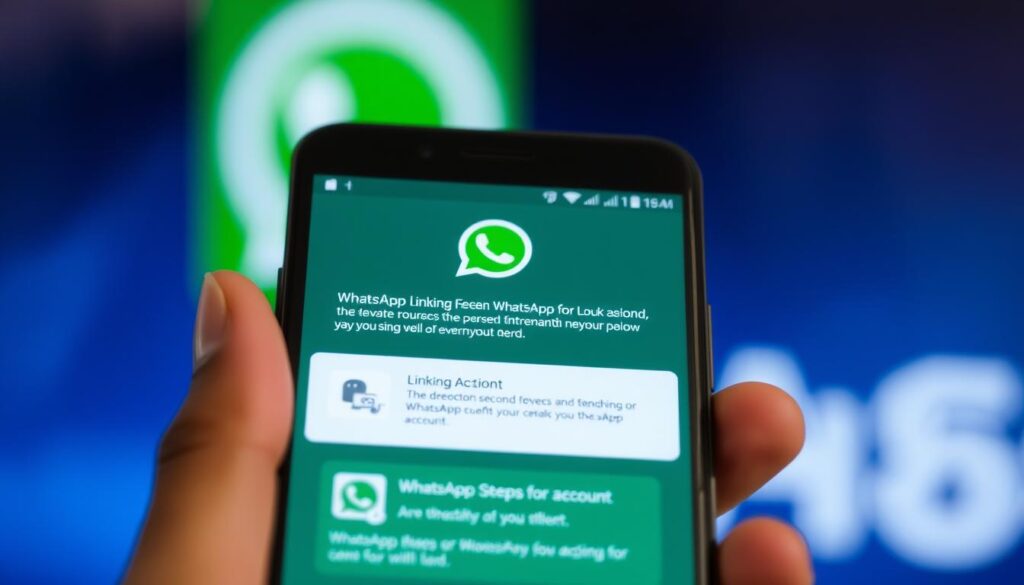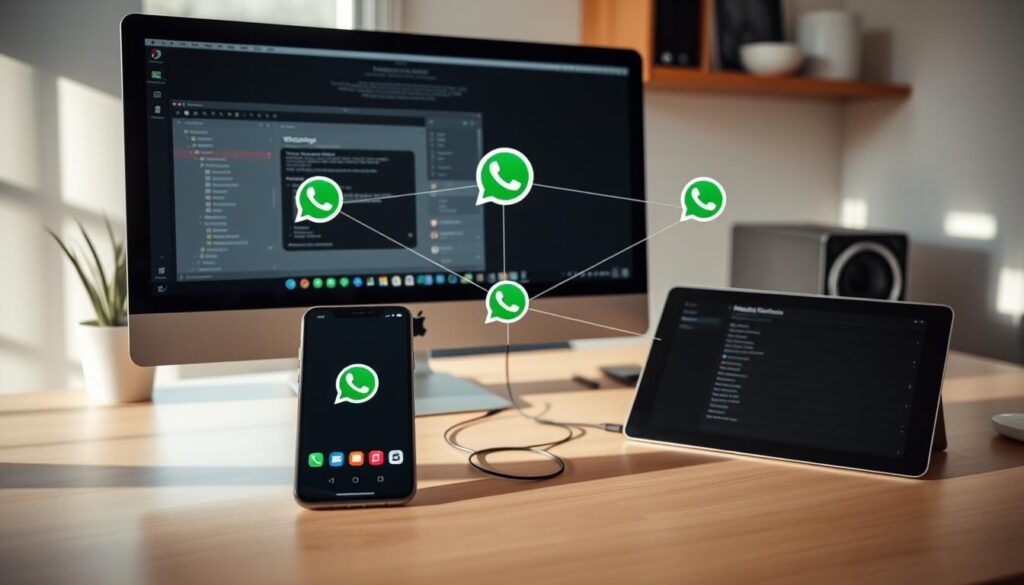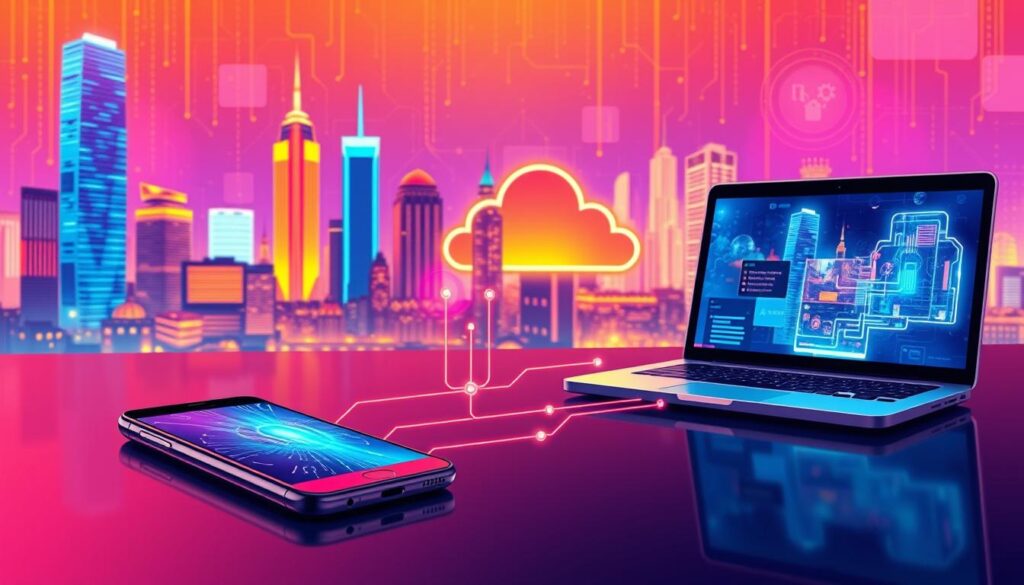Many users are curious about multi-device support for WhatsApp. They wonder if it’s possible to use WhatsApp APK on multiple devices at the same time.
The idea of WhatsApp APK multi-device support excites users. They hope to sync their WhatsApp account across different devices. This would make it easier to stay in touch.
Key Takeaways
- Understanding the concept of WhatsApp APK multi-device support.
- Exploring the possibility of using WhatsApp on multiple devices.
- Learning about the benefits and limitations of multi-device support.
- Discovering how to access WhatsApp on multiple devices.
- Understanding the security implications of using WhatsApp on multiple devices.
Understanding WhatsApp’s Evolution to Multi-Device Support
WhatsApp’s journey to support multiple devices is a big step forward. At first, it was only for one device. But, users wanted more flexibility, leading to multi-device support.
The History of WhatsApp’s Single-Device Limitation
WhatsApp used to only work on one phone. This was because it relied on the phone number to identify users. But, users wanted to use WhatsApp on more than one device.
The Introduction of Multi-Device Functionality
WhatsApp’s update to support multiple devices was a big change. Now, users can link their account to many devices. This includes phones, tablets, and computers. The whatsapp linked devices apk makes it easy to use WhatsApp on different platforms.
The multi-device support feature has been a hit with users. It makes WhatsApp more convenient and flexible. Now, users can access WhatsApp from various devices, making it more user-friendly.
WhatsApp APK Multi Device: How It Actually Works

It’s important to know how WhatsApp APK works for multi-device use. This feature lets users use their accounts on many devices. These include smartphones, tablets, and desktops.
Defining WhatsApp APK and Its Official Features
WhatsApp APK is the file for the WhatsApp app on Android. It has cool features like end-to-end encryption and group chats. Now, it also lets users link their accounts to many devices.
The key features of WhatsApp APK multi-device support include:
- Seamless syncing across devices
- End-to-end encryption on all linked devices
- Ability to use WhatsApp on multiple devices simultaneously
The Technical Architecture Behind Multi-Device Support
WhatsApp’s multi-device support uses a complex system. When you link a device, the first device makes a QR code. Then, the second device scans it.
| Device Type | Linking Method | Data Syncing |
|---|---|---|
| Android | QR code scanning | Real-time syncing |
| iOS | QR code scanning | Real-time syncing |
Official Methods to Use WhatsApp on Multiple Devices
WhatsApp has made it easier to use its service on multiple devices. This change lets users access WhatsApp from different devices. It’s great for managing both personal and work messages.
WhatsApp Web and Desktop Applications
WhatsApp Web and Desktop apps are key ways to use WhatsApp on multiple devices. They let users sync their WhatsApp account with computers or other devices. This makes messaging smooth across different screens.
To start, users just scan a QR code on their computer with their phone. This connects their WhatsApp account to the device. They can then send messages, share files, and make calls.
The Companion Mode Feature Explained
The Companion Mode feature is another way to link WhatsApp to multiple devices. It’s perfect for managing WhatsApp on different phones or tablets. Companion Mode keeps the primary device connected while using WhatsApp on others.
This ensures messages and media are synced across all devices. It’s a handy feature for those who need to use WhatsApp on various devices.
Differences Between Primary and Secondary Devices
It’s important to know the difference between primary and secondary devices when using WhatsApp. The primary device is where WhatsApp is first installed. Secondary devices are linked to the primary using WhatsApp Web, Desktop, or Companion Mode.
While secondary devices can access WhatsApp, some features might be limited. They can’t match the full functionality of the primary device.
Can You Use WhatsApp APK on Two Phones Simultaneously?
Many are curious if WhatsApp APK can be used on two phones at once. WhatsApp has changed to support multiple devices. This is a big update for users.
The Official Position from WhatsApp
WhatsApp now lets users link their account to many devices, including phones. This change is a big move from the old rule of using WhatsApp on just one device.
“WhatsApp’s multi-device support allows users to link their account to multiple devices, making it more flexible and accessible.”
Recent Updates That Enable Multi-Phone Support
Recent updates let users link their WhatsApp account to a second phone. This means you can send and receive messages on both devices. It’s great for those with multiple SIM cards or devices for work and personal use.
Device Compatibility Requirements
To use WhatsApp on multiple phones, some requirements must be met. Devices need to run compatible operating systems, and WhatsApp must be updated.
| Device Type | Operating System | WhatsApp Version |
|---|---|---|
| Primary Phone | Android 5.0+ | 2.22.22 or later |
| Secondary Phone | Android 5.0+ or iOS 12+ | 2.22.22 or later |
By making sure both devices meet these needs, users can link their WhatsApp accounts. This way, they can enjoy using WhatsApp on multiple phones.
Step-by-Step Guide to Link WhatsApp to a Second Phone

Want to use WhatsApp on two phones? Here’s a simple guide to help you. Linking your WhatsApp to a second phone is handy for personal or work use.
Prerequisites Before You Begin
Make sure both phones have a good internet connection. Also, have the latest WhatsApp on both devices.
WhatsApp works on Android and iOS. This makes it easy to use on different phones.
Linking Process for Android Devices
To link WhatsApp on an Android phone, start on your main device. Go to Settings and choose ‘Linked Devices.’ Then, tap ‘Link a Device’ and scan the QR code on your other phone.
On your other phone, open WhatsApp and follow the steps. It’s easy and doesn’t need much tech know-how.
Linking Process for iOS Devices
For iOS users, it’s almost the same. On your main device, open WhatsApp, go to Settings, and pick ‘Linked Devices.’ Tap ‘Link a Device’ and scan the QR code on your other iOS device.
On your other iOS device, open WhatsApp and follow the instructions. This lets you sync your WhatsApp data easily between devices.
WhatsApp Linked Devices APK: Limitations and Considerations

WhatsApp’s multi-device feature is handy, but it has its downsides. When using WhatsApp linked devices APK, there are key things to remember for a smooth experience.
Maximum Number of Linked Devices Allowed
WhatsApp lets you link up to four devices to your main account. This means you can use WhatsApp on four extra devices, along with your main phone. This limit is important for both personal and business users, as it affects how you manage your chats across devices.
Feature Restrictions on Secondary Devices
Secondary devices can use most WhatsApp features, but not all. Some features on your main device might not work the same way on linked devices. It’s important to know these limits to avoid any trouble. Some restricted features include:
- Making or receiving calls directly from a secondary device (depending on the device and WhatsApp’s settings)
- Accessing certain settings or preferences
- Using WhatsApp for business, like accessing business features or catalogs
Battery and Data Usage Implications
Using WhatsApp on multiple devices can affect your battery and data. Linked devices sync data with your main device, which can increase data use and battery drain if not managed well. To reduce this, users can:
- Keep an eye on data use and adjust settings as needed
- Make sure all devices are charged when syncing big amounts of data
- Use Wi-Fi instead of mobile data when you can to save data
Knowing these limits and considerations helps users get the most from WhatsApp’s linked devices feature while avoiding problems.
Data Synchronization Between Multiple Devices

WhatsApp makes it easy to keep your messages in sync across devices. This means you can chat on any device and see all your messages. It’s all about keeping your conversations up-to-date everywhere.
How Messages and Media Are Synced
Linking devices to your WhatsApp account syncs messages and media securely. So, any new messages or photos you get are instantly available on all your devices. This keeps your conversations fresh, no matter which device you’re using.
Key aspects of the syncing process include:
- End-to-end encryption to maintain privacy
- Automatic syncing of new messages and media
- Access to chat history on all linked devices
Managing Chat History Across Devices
WhatsApp makes it easy to manage your chat history across devices. Your chat history is synced, so you can start where you left off on any device. Here’s how to keep your chats organized:
- Use the chat backup feature to ensure your conversations are safely stored
- Regularly review your chat history to keep your conversations organized
- Utilize the search function to quickly find specific messages across all your devices
Understanding data sync and chat history management lets you get the most out of WhatsApp. It’s all about making your messaging experience better across all your devices.
Troubleshooting Common Issues with Multi-Device Setup
Using WhatsApp on multiple devices can sometimes cause problems. It’s important to know how to fix these issues for a smooth experience.
Connection Problems Between Devices
Connection issues often happen when devices aren’t on the same network. Try restarting your devices or reinstalling WhatsApp to fix this.
Here’s a quick checklist to troubleshoot connection issues:
- Ensure all devices are connected to the internet
- Restart your primary device and secondary devices
- Check for WhatsApp updates on all devices
Missing Messages or Media
Missing messages or media might be due to syncing problems. Make sure your primary device is online and WhatsApp can sync data. If problems continue, try unlinking and relinking your devices.
To avoid missing messages, it’s essential to:
- Keep your primary device connected to the internet
- Regularly update WhatsApp on all linked devices
Performance Issues on Secondary Devices
Performance problems on secondary devices might be due to low storage or outdated software. Make sure your devices have enough space and are up to date.
| Issue | Solution |
|---|---|
| Slow performance | Free up storage or update your device’s OS |
| App crashing | Reinstall WhatsApp or restart your device |
Security and Privacy When Using WhatsApp on Multiple Devices
WhatsApp is now available on many devices, raising security concerns. The app’s new feature lets you use it on different devices. But, it’s important to know how it affects your privacy and security.
End-to-End Encryption Across Devices
Many users worry about WhatsApp’s end-to-end encryption on multiple devices. Luckily, WhatsApp keeps all messages, calls, and photos safe. Only the sender and receiver can see the content, keeping your chats private and secure.
This encryption works on all linked devices, making your experience safe everywhere. WhatsApp uses a strong encryption to protect your data.
Managing Privacy Settings on Each Device
WhatsApp also lets you control your privacy settings on each device. You can decide who sees your last seen status, profile picture, and more. Adjust these settings on each device to keep your privacy as you like.
It’s key to only link trusted devices to your WhatsApp account. Check your linked devices often and update your privacy settings as needed. This keeps your WhatsApp experience safe on all devices.
Practical Tips for Managing Conversations Across Devices
To get the most out of WhatsApp on multiple devices, you need a few strategies. Managing chats across devices boosts productivity and keeps you connected with others.
Organizing Notifications and Alerts
Organizing notifications is key to managing chats across devices. You can adjust notification settings on each device to fit your needs. For example, you might mute group chats on your secondary device to avoid distractions.
WhatsApp lets you change notification tones and vibrations. This way, you can tell what kind of message you got without looking at your device.
- Customize notification settings for individual chats or groups.
- Use different notification tones for different contacts.
- Enable or disable notifications for specific devices.
Strategies for Business and Personal Use
Using WhatsApp on multiple devices for work and personal life needs organization. You can use one device for work and another for personal chats. This approach helps manage your time better and keeps your chat lists tidy.
Comparing WhatsApp’s Multi-Device Support with Competitors
More messaging apps now offer multi-device support. This has made the market more competitive. Apps like WhatsApp, Telegram, and Signal are competing to see who offers the best multi-device support.
Telegram’s Multi-Device Approach
Telegram lets users run the app on many devices at once. This includes desktops and mobile devices. It’s great for those who need to check messages on different platforms.
Telegram’s multi-device support includes:
- Seamless synchronization across devices
- Support for multiple device types, including tablets and desktops
- Robust security features, maintaining end-to-end encryption
Signal and Other Messaging Apps
Signal is known for its strong encryption and multi-device support. But, it has some limits compared to Telegram. Users can link many devices, but the main device must be a phone.
| Feature | Telegram | Signal | |
|---|---|---|---|
| Multi-Device Support | Yes, up to 4 devices | Yes, multiple devices | Yes, multiple devices |
| End-to-End Encryption | Yes | Yes, for secret chats | Yes |
| Desktop Support | Yes | Yes | Yes |
Conclusion: The Reality of Using WhatsApp on Multiple Devices
Using WhatsApp on multiple devices is now easier, thanks to multi-device support. This feature lets users access their accounts on various devices. This includes smartphones, tablets, and desktop computers.
WhatsApp’s official methods, like WhatsApp Web and Companion Mode, help link accounts to secondary devices. While there are some limits, like device compatibility and data syncing, the experience is smooth.
In conclusion, WhatsApp’s multi-device support has changed how we talk across different devices. By knowing the features, limits, and best ways to use it, users can get the most out of WhatsApp. This makes it a more powerful tool for both personal and business chats.
